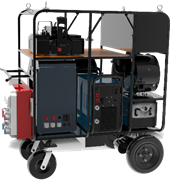Application and programming skills of welding robots
Date:2021-11-25 Views:913
Industrial robots are composed of an operating machine (mechanical body), a controller, a servo drive system, and a detection sensing device. They are an electromechanical integrated automated production equipment that simulates human operation, automatic control, repeatable programming, and can complete various tasks in three-dimensional space. They are particularly suitable for flexible production of multiple varieties and batches.

It plays a very important role in stabilizing, improving product quality, improving production efficiency, improving labor conditions, and rapidly updating and replacing products. Since the early 1960s, when humans created the first industrial robot, industrial robots have shown great vitality. In just over 40 years, industrial robot technology has developed rapidly.
Industrial robots have been widely used in the production of industrialized countries. At present, industrial robots have been widely used in the automotive and automotive component manufacturing industry, mechanical processing industry, electronic and electrical industry, rubber and plastic industry, food industry, wood and furniture manufacturing industry, and other fields. In industrial production, industrial robots such as welding robots, assembly robots, spraying robots, and handling robots have been widely adopted.
Welding robots are industrial robots engaged in welding (including cutting and spraying), which mainly include two parts: robots and welding equipment. Among them, the robot is composed of a robot body and a control cabinet (hardware and software); Welding equipment, such as arc welding and spot welding, consists of welding power supply (including its control system), wire feeder (arc welding), welding gun (clamp), and other components.
Industrial robots are composed of an operating machine (mechanical body), a controller, a servo drive system, and a detection sensing device. They are an electromechanical integrated automated production equipment that simulates human operation, automatic control, repeatable programming, and can complete various tasks in three-dimensional space. They are particularly suitable for flexible production of multiple varieties and batches.

It plays a very important role in stabilizing, improving product quality, improving production efficiency, improving labor conditions, and rapidly updating and replacing products. Since the early 1960s, when humans created the first industrial robot, industrial robots have shown great vitality. In just over 40 years, industrial robot technology has developed rapidly.
Industrial robots have been widely used in the production of industrialized countries. At present, industrial robots have been widely used in the automotive and automotive component manufacturing industry, mechanical processing industry, electronic and electrical industry, rubber and plastic industry, food industry, wood and furniture manufacturing industry, and other fields. In industrial production, industrial robots such as welding robots, assembly robots, spraying robots, and handling robots have been widely adopted.
Welding robots are industrial robots engaged in welding (including cutting and spraying), which mainly include two parts: robots and welding equipment. Among them, the robot is composed of a robot body and a control cabinet (hardware and software); Welding equipment, such as arc welding and spot welding, consists of welding power supply (including its control system), wire feeder (arc welding), welding gun (clamp), and other components.











